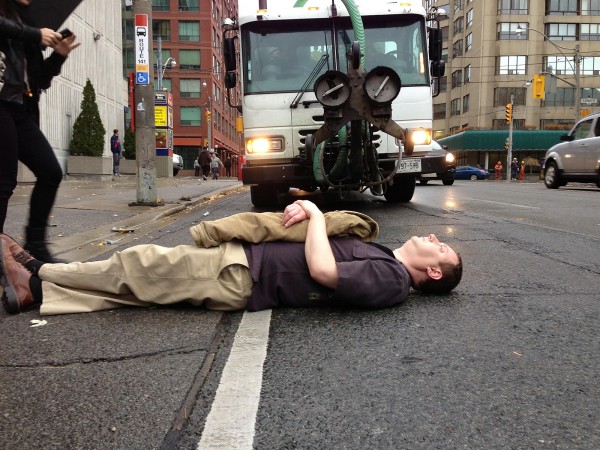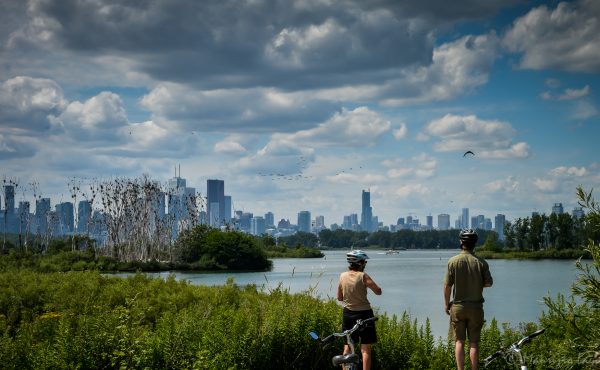Toronto has only one short and unflattering walk-on part in Janette Sadik Khan’s fascinating account of her experiences as the crusading transportation commissioner for former New York City mayor Michael Bloomberg.
There, in the index under “bike lane antipathy,” we get two measly pages about the 2012 Jarvis Street debacle, plus Shawn Micallef’s iconic picture of the guy lying in the path of the paint removing truck.
And really, we didn’t, and don’t, deserve any more.
Yesterday, as Sadik-Khan and her co-author Seth Solomonow swept into town for a lecture and dinner hosted by Ryerson’s City Building Institute, the public works and infrastructure committee proved the point. They couldn’t muster a decision on the Bloor bike lane pilot project, punting the staff report to council, where it may well die the death of a thousand small studies.
Some wag once observed that the fights inside academe are so vicious because the stakes are so low. Surely the same could be said of a pilot project like the Bloor bike lane. Even if the test doesn’t work out, I’ll go out on a limb and predict that the city’s economy and transportation network won’t collapse as a result. Indeed, the magnitude of council’s dithering on this exhaustively scrutinized idea is inversely proportional to the risks entailed by such experiments, the success of which have been amply proven in much more challenging urban environments.
Sadik-Khan, if we care to listen to her, has some trenchant learnings about how the city could short-circuit the extreme analysis-paralysis that becomes apparent at such moments. As the bureaucrat who re-engineered complicated intersections to create dozens of new pop-up plazas across New York City and deployed hundreds of kilometres of protected bike lanes, Sadik-Khan well understands the nature of political push back, and has the welts to prove it.
But she also demonstrated, with the crucial support of a mayor who brought vision and intellectual rigour to the job, that it’s possible to change the status quo using a combination of savvy tactics (e.g., pilot projects), insightful data, and the force of (real, as opposed to manufactured) public opinion.
While it’s true that Sadik-Khan served a singular public figure within a government structured to provide the mayor’s office with sufficient executive authority to carry out a mandate, she insists the public space revolution her team brought to Gotham was anything but a forgone conclusion. “To plan is human,” she likes to say, “but to implement is divine.”
Herewith, some of Sadik-Khan’s key insights about implementation:
Use traffic safety to drive public space improvements
When Bloomberg hired Sadik-Khan, her first move was to take the broad goals set out in PlaNYC, his long-range vision, and translate them into a strategic plan for the Department of Transporation, something that had never been done before. (The City of Toronto’s Transportation Services has no such mission statement.) The plan laid out key objectives, including a goal to reduce traffic fatalities in NYC by 50% by 2030.
Toronto’s fatality count has nosed up in recent years (one death per 45,000 people), while New York’s has dipped to levels not seen in a century (one per 64,000). Pedestrian and cyclist safety measures, from protected lanes to traffic calming and speed limit reductions, improve public spaces. And, here’s the most important point: when council sets targets for itself, the city has an incentive to move the marker by implementing changes in the configuration of our streets. Garden-variety public safety campaigns, such as this spring’s version, won’t do the trick (i.e., people will continue to die).
Leverage data to show how success can beget more success
Before Sadik-Khan began her campaign, New York businesses were just as fearful of changes to the street network as their counterparts are here: What happens if the customers can’t park? What happens to delivery vehicles? Will traffic jams choke off retail streets? New York’s equivalent to local business improvement areas, she explains, were often the most vehement opponents to bike lanes, new plazas and other changes.
Bloomberg, a man who made billions packaging and selling information, had a mantra, Sadik-Khan recounts: “In God we trust. Everyone else bring data.” After setting up a pilot project (e.g., new bike or bus lanes), her DOT officials hustled to collect information on traffic flows through re-configured intersections, pedestrian and cyclist counts and other metrics. The figures invariably showed how these changes tended to put more potential customers on the street and in front of businesses that had feared the fall-out of lost traffic. Once they saw the data, she says, the BIAs became some of the DOT’s most important allies in subsequent projects. A virtuous circle, in other words.
This is an approach pioneered by the famous Danish planner Jan Gehl, who has used this kind of data gathering in cities like Copenhagen and Melbourne (and whose firm has been retained by the City as part of the CoreTO project).
But we don’t do a very good job of collecting, tracking and publicly reporting this kind of information. The Bloor bike lane staff report promises to ante up before and after cycling and vehicle counts, and survey businesses online. But it’s not clear what the base line data is (the numbers are not in the report), nor, it seems, will the evaluation include anything on pedestrian activity, public realm use, or other indicators on the quality of street life along that stretch. Indeed, on the one major Toronto arterial that has seen a significant re-configuration prior to the recently completed Queen’s Quay West reconstruction – St. Clair from Yonge to Keele, for the right-of-way – the city has never bothered to compile data showing how the street has changed since dedicated streetcar line went into operation in 2009. No data, ergo no progress to report.
Listen to the public, not the noisemakers
During the most intense period of her reforms, Sadik Khan says DOT officials would hold up to 2,000 public meetings per year, a number that confirms an extensive attempt to engage the public. But to create better conversations, she asked her officials to change the dynamic of those sessions. Instead of beginning with a presentation of a city plan, and thus creating a target for NIMBYs, Sadik-Khan’s officials would open meetings with a simple question: “What problem are you trying to solve?” It’s a brilliant means of engaging a skeptical public, and turning oppositional meetings into problem-solving exercises.
As the campaign gained moment, the DOT doubled down its efforts to end-run the naysayers by inviting communities to submit applications for new plazas through the Neighbourhood Plaza Partnership. Consider the appealingly subversive nature of such a shift: instead of bureaucrats dictating what goes where, communities could identify such spaces and then embark on a process to see them brought to fruition. It’s no surprise, in fact, that Sadik-Khan’s plazas have cropped up across the five boroughs. The earliest ones — in DUMBO, in front of Macy’s and along Broadway in Times Square — showed the rest of the city (and the world) what was possible. (It’s also important to note, for all the suburban fussbudgets on Toronto council, that city politicians representing NYC’s outer boroughs couldn’t veto plans to create the now iconic plazas along Broadway in Manhattan.)
To nail it all down, regular public opinion polling, she points out, has consistently revealed the New Yorkers were “way ahead” of local politicians, string-pullers and the pundits when it came to all the new bike lane and bike sharing infrastructure. Such findings not only provided political cover; they revealed proof of concept, which is that the road network, accounting for as much as a third of all urban space, represents an invaluable asset that can be used much more productively in dense cities looking for smart and inexpensive ways to improve quality of life, boost local economies and reduce environmental damage.
Now a consultant with Bloomberg Associates (which offers free advice on urban regeneration to cities), Sadik-Khan pays homage to Frank Sinatra when she riffs about what New York can teach other cities about the future of their streets:
“If you can remake it here,” she writes, “you can remake it anywhere.”
Maybe even in Toronto. Maybe….
top photo by Teri Tynes (cc); protest photo by Shawn Micallef






